
Publisher:
Bonnie King
CONTACT:
Newsroom@Salem-news.com
Advertising:
Adsales@Salem-news.com

~Truth~
~Justice~
~Peace~
TJP
Jul-19-2011 03:25

 TweetFollow @OregonNews
TweetFollow @OregonNews
The Himalayas-Once Moaning, now Groaning
Arun Shrivastava CMC Exclusive for Salem-News.comAnalyzing militarization and exploitation of natural resources in this mystic place.
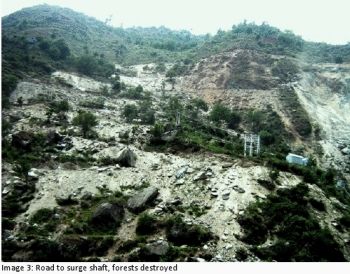 Himalaya Mountains damaged; Road to surge shaft, forests destroyed. Photo: Rahul Saxena; a member of the research team and a forestry expert in India |
(PALAMPUR, Himachal Pradesh, India) - The Himalayas are being pounded again. Timber was stolen first; medicinal and aromatic herbs next. Now power projects are stealing water, life line for 30 million mountain folks and 3 billion in the Himalayan-water-dependent nations, as far as Vietnam. [1]
As South Asian and Chinese governments felt the heat of electricity shortage, the Himalayan potential for hydro-power was ‘reassessed’ at 500,000 MWe [Megawatt of installed electricity generation capacity] detailed in Map 1.
The reassessed country-wise potential is:
Pakistan: 41,722 MW,
India 108,143 MW;
Nepal 83,000 MW; and
Bhutan 16,000 MW. [2]
Occupied Tibet will ensure the Chinese about 250,000 MWe.
Given the scale of hydro-electric projects in ecologically sensitive and seismically active mountain range, this paper raises questions on sustainability of these projects and survival of Asians in the mountains and in the plains.
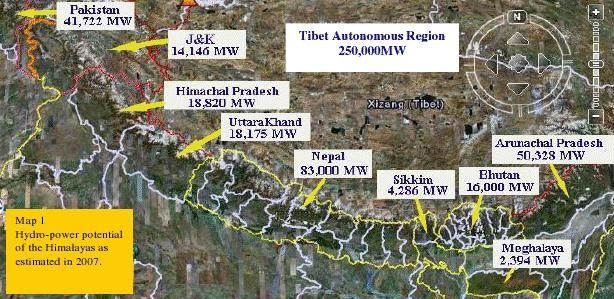
Global coolant No. 2 and the Himalayan water resources
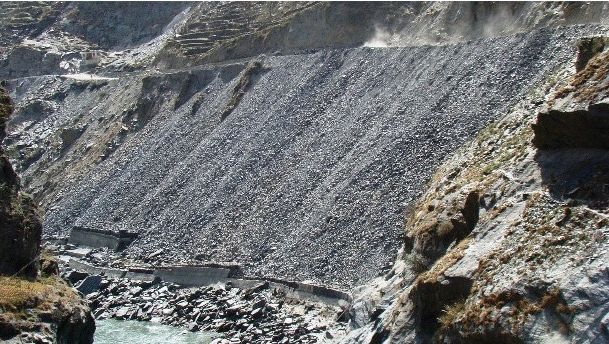 Reckless dumping of muck and debris on once pristine glacial rivers. Photo: Rahul Saxena |
The Himalayan glaciers serve as world’s second largest heat sink after the Antarctic and moderate global climate. The 18,065 glaciers spread over nearly 35,000 square kilometers hold about 3,735 cubic kilometers of ice mass making it world’s second largest glacier resource. A recent estimate by a team of Chinese scientists shows that 95% of the statistical glaciers are receding and that water resources in the Himalayas are declining.[3]
Below the snow line, sponge-like mountains hold enormous amount of fresh water estimated at 12,000 cubic kilometer. You dig a hole at any slope covered by dense foliage and water starts pouring out. Glaciers don’t melt during winter; it is the slowly seeping waters all year round that make Himalayan Rivers perennial.
Deforestation, diversion of water, crude methods of construction and uncontrolled dumping of debris at construction sites are responsible for turning many perennial rivers seasonal, drying up of many seasonal rivers and emergence of streams that were never there. Floods have become more furious and droughts more severe, as recent reports from China, India and Pakistan show.
Ecosystems and sustainability of civilizations
Ecosystems provide 24 critical goods and services ensuring survival of us earthlings. These include vital goods like food, fodder, fiber, freshwater, fuel, medicinal and aromatic herbs, timber; vital regulating services like climate regulation, natural hazard protection, erosion prevention, food for wild animals, water purification, seed dispersal, even disease regulation; and supporting services include habitat provisioning, nutrient cycling, soil formation and retention, oxygen production, and water cycling. [4] Global Biodiversity outlook
Ecosystems also provide valuable cultural services. They help evolve spiritual and religious values and local knowledge systems. When you go for nature walks think of the recreation and aesthetics that have a calming and invigorating effect on body and mind; these are functions of the ecosystems.
It’s been estimated that world’s ecosystems contribute about 70 trillion dollars worth of goods and services, more than the sum of world’s gross domestic product.
How much ecosystem goods and services mean to the Himalayan communities and the people dependent on Himalayan waters? We don’t know in monetary terms but I do have some data on how the hydro-electric projects are affecting their livelihoods and quality of life.
In course of my research at three river basins, meetings at 27 villages and interviews of nearly 5,000 randomly selected households in a Himalayan state [Himachal Pradesh, India], I found that 17 of the 24 goods and services are affected. Maximum adverse impact was on goods, less so on services but we don’t know the long term consequences. [5]
Reckless construction, crude method for blasting tunnels, dumping of overburden and debris in unauthorized places, illegal wood cutting from prime forest areas, crude and irresponsible ways of making access roads have caused havoc in every project area. Grazing lands have become stone quarries, rivers are dying, water resources are drying up, slopes have become unstable, and large areas look like bombed out regions. [See images 1 to 4]
Eleven issues of inequities perpetrated by project authorities [both public and private] including denial of access to, and shared benefits from, ecosystems, and extinguished usufruct rights, frequently without adequate and timely compensation were also documented with hard evidences. [6]
I sent a few of the 2000 photographs my team and I took at various river basins to a German friend and he found the situation in the Himalayas similar to what’d happened in Germany from breathless expansion of hydro-electric projects during the inter-war years that took decades for the ecosystems to recover. The Himalayan community does not have that luxury and we don’t know the unintended consequences of concentrating so many projects in one fragile region of global importance.
Plundering Nature for economic growth?
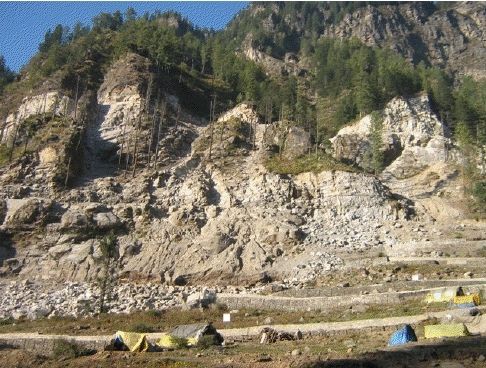 Gouging out mountains for coarse aggregate, this time pasture destroyed. |
Let us be fair to South Asian nations. Analysis of world electricity consumption data shows that about 50% is consumed by EU and USA alone; China consumes about 14%, India little over 3%, and South Asia less than 4% of world consumption.
Thus, the world's 3 billion people in China and South Asia consume less than 20% of world’s electricity.[7] Thus, South Asia needs electricity, five times increase in the current installed capacity for generation to achieve world average. However, many renewable and sustainable options have not even been considered.
About 89% of world hydro-electric power consumption is accounted for by Asia and Oceania [about 25%], North America [about 23%], Central and South America [about 23%] and Europe [18%].
Since over 50% of 1.6 billion South Asians do not have access to electricity, Governments are pushing ahead with generation at any cost. At projected 8-9% GDP growth rate, India for example, would require 800,000 MWe by 2032, up from 131,000 MWe in 2008, much of it planned to be harnessed from coal, hydro and nuclear.
According to past data and revenue records in the sample state, 0.48 hectare of land is required for each MWe of installed capacity in the Himalayan region. The lower demand for land is due mainly to the construction of run-of-the-river power stations in which a diversionary dam is built and water is diverted through tunnels to the turbine; the water is then released through tail race either in the same river or diverted to another depending upon the cost. At many project sites siltation chambers and entire power houses have been constructed under the mountain. You can’t see them, except power lines and bone dry rivers.
The demand for land for roads, administrative building, housing for engineers and transmission towers is additional.
For the planned and operational power plants, it reasonable to peg the figure at 250,000 hectares of prime forests, private lands and common property resources likely to be gobbled up, additional 10-15% for ancillary facilities, and much more for transmission towers.
The Oil flowing from ‘The Himalayas’
"Water is to us what oil is to Arab," said the King of Bhutan. (8) There could not have been a more absurd comparison but then rulers must be tolerated. Accounting adjustment for idiocy as factor input, monopoly of non-performing political assets, does not appear in Gross Domestic Product or Gross Domestic Happiness calculations.
Arabian countries are largely sand dunes; the Himalayas are not. Botanists confirm that even today they do not have complete record of the mega-biological diversity of the Himalayas.
Militarization and exploitation of natural resources
And it is not merely the “Himalayan oil” that companies and countries are after. It has huge deposits of strategic and precious metals and minerals. Japan wanted to exploit Beryllium reserves in Nepal, a fissile material, back in the 1960s. China’s occupation of Tibet, cited by intelligence experts as the greatest failure of the CIA, was driven by its immense natural wealth. And the Chinese have already destroyed 40% of Tibet’s prime forests for high quality timber.
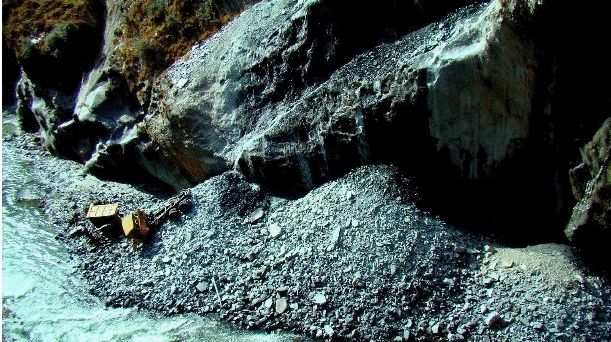 Militarization and exploitation of natural resources. Photo: Rahul Saxena |
For these reasons, the Himalayas are the most heavily militarized mountain region on earth; the Chinese in the North, the Indians in the South and the Pakistani in the West. Some estimates place that China alone has permanently stationed possibly up to half a million soldiers and is also accused of dumping nuclear waste in Tibet highlands.
The Siachen, world’s longest glacier, remains the most heavily militarized.
The larger species of a fish called Mahseer [in India and Pakistan], also called Tor, much valued for gaming and as food, have suffered severe decline and are now considered threatened due to water pollution, habitat loss and overfishing. Himalayan trout is facing similar problems; the exotic rainbow trout got nearly decimated from a viral disease in one Himalayan valley known as Tirthan suspected to have originated from chemical pollution. Local officers of the Department of Fisheries fear near total loss of aquatic life from these projects.
If you take a walk through the Park areas and conserved forests, you will find apricot, plum, and many other varieties of wild fruits. These fruits provide food and cash income to local communities. So do the thousands of medicinal and aromatic plants.
Over-exploitation from commercial pressures is threatening specie loss and also loss of cash income. To give you an idea: the white kernel of apricot seed fetches about 100 rupees per kilogram to villagers who collect these from forests. This is sold to oil expellers who cold press the seed and extract apricot oil, which is sold to cosmetics manufacturers for anything from 1000 to 2000 rupees per kilogram. Cold pressed apricot oil is the base material for expensive cosmetics.
The situation has worsened over the years especially after World Bank’s recommendation of basin-wide exploitation of water resources. Of course, they also recommended that environmental issues and consent of local communities should also be taken into account while planning, but who cares for the ecosystems and rural livelihoods? [9]
This sort of genocidal strategy goes on and on. I fail to understand how the ruling elite itself will survive having poured the sixth bowl. The wrath of God takes different forms and shapes.
References:
- See map of basins here:
http://www.transboundarywaters.orst.edu/publications/register/images/asia.gif]
- Compiled from several sources: [i] Central Electricity Authority [India data]; [ii] Federation of NGOs, Nepal [Nepal data] and [iii] Bhutan Government website [Bhutan data]; and [iv] www.siteresources.worldbank.org/PAKISTANEXTN/ Resources/pakistan-Development-Forum-2004/PSD.pdf [Pakistan data]. The reference period is 2004-07. The data is at best indicative.
- Yao Tandong, Liu Shiyan, Pu Jianchen, Shen Yongping and Lu Anxin, Recent glaciers retreating in High Asia and their impact on the water resources of Northwest China, Science in China, 2004;
- Global Biodiversity Outlook 2; CBD; 2007; www.biodiv.org/GBO2; page 14.
- Shrivastava, AK, et. al.; Impact of hydro-electric projects on ecosystems, communities and livelihoods; 2009; Findings to be presented in a National Conference. The findings of the pilot before the full scale study was presented in an international conference on sustainable development held at Islamabad, Pakistan, in 2007.
- Ibid
- International Energy Agency database
- ‘WAPCOS to prepare DPR for Bhutan hydel project’; The Hindu; March 3, 2004;
- Schneider, AK; ‘The World Bank’s Legacy of Funding Hydropower Projects in India: Nathpa Jhakri’; International Rivers Network; October 2004;
http://www.irn.org/programs/
india/nathpa_jhakri.php?id=archive/NathpaJhakriReport.html
Arun Shrivastava was financially assisted by an anonymous donor to the tune of US$50,000 to conduct the studies lasting nearly two years; local communities also helped by providing free accommodation and often free food to the study team. Five subject specialists and 20 researchers were involved in data collection. He regularly travels to the Himalayan region and is closely involved in community-based movements opposing large projects in the Himalayas.
 Arun Shrivastava is Salem-News.com's South Asia Correspondent. An accredited management consultant, Arun is also a highly experienced researcher and writer. He studied in India and England and returned to India in 1989, after a brief stint as senior officer with Economic Development Unit of Birmingham (UK). From 1989 to 1994, he taught Strategic Management and Long Range Planning to MBA students at International Management Institute in Delhi.
Arun Shrivastava is Salem-News.com's South Asia Correspondent. An accredited management consultant, Arun is also a highly experienced researcher and writer. He studied in India and England and returned to India in 1989, after a brief stint as senior officer with Economic Development Unit of Birmingham (UK). From 1989 to 1994, he taught Strategic Management and Long Range Planning to MBA students at International Management Institute in Delhi.
About twenty years ago he founded two institutions, one for consulting and another for doing sponsored research work; today both are known for excellence. Since the events of 9/11, he has devoted much of his time to researching NWO issues. Arun also moderates International Human Rights Organizations’ discussion group.
Salem-News.com is very pleased that Arun Shrivastava chose to join our dynamic team which has been paying increasing attention to problems taking place in India. He is Salem-News.com's 94th writer and his presence allows us to better cover important events in an increasingly interconnected world community.
You can send an email to Arun Shrivastava at this address: arunshrivastava.1951@gmail.com
Articles for July 18, 2011 | Articles for July 19, 2011 | Articles for July 20, 2011





Salem-News.com:
Terms of Service | Privacy Policy
All comments and messages are approved by people and self promotional links or unacceptable comments are denied.
Devesh Pant July 3, 2012 3:53 am (Pacific time)
The hydro-power developed is largely consumed by power intensive industries like steel furnaces and the villagers in the hills don't get any real benefits. The latter are being incited to clamour for more hydro-plants without proper studies. By the time the "Power Station builders have had their "fill" Himalayan ecology will have been destroyed.
Freida Mullens July 19, 2011 1:50 pm (Pacific time)
One needn't read more than the words 'World Bank' to have an understanding of what is taking place in the Himalayas.
Matt Johnson - Malibu July 19, 2011 4:06 am (Pacific time)
I am genuinely sorry to hear of this, I honestly had no idea and hope that there are plans that somehow can be enacted to save this incredible place.
[Return to Top]©2025 Salem-News.com. All opinions expressed in this article are those of the author and do not necessarily reflect those of Salem-News.com.